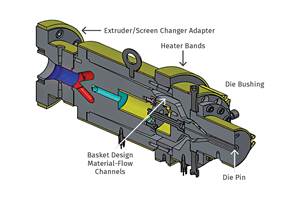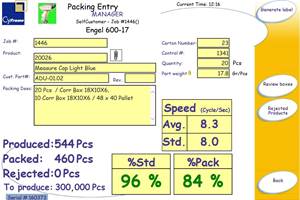EXTRUSION: When Internal Screw Cooling Makes Sense
Internal screw cooling could help you solve solids-feeding and burning problems.
Screws sometimes need to be cooled internally to optimize their performance. In processes where solids feeding is the issue, the screw is generally cooled internally only through the solids-feeding area. The reason to cool the screw this way is to prevent polymer from sticking to its surface until some feed pressure is developed to “clean” the screw by conveying material forward.
Solids feeding is based on the polymer sticking to the barrel and slipping on the screw surface. Think of what happens to a wood screw when you drive it though a two-by-four. It’s the same concept in extrusion. The balance between sticking and slipping is typically maximized for better performance by using a higher temperature on the barrel wall than on the screw surface. This lets you obtain the highest possible difference between the coefficients of friction (COF) on the opposing surfaces. Remember that the screw does not touch the barrel in the feed section, so cooling the feed throat has a minimal effect on the screw temperature.
When temperature is increased, there will be an increase in COF between polymer and metal surface. As soon as polymer starts sticking to the screw surface, the imbalance of forces that conveys the polymer particles forward will be reduced, and as a result feed rate will slow and/or become erratic.
Screw cooling is typically used for low-melting or softening polymers, such as polystyrene, particularly if the mixture also contains regrind. That’s because regrind often contains small particles that can quickly adhere to the screw surface. Internal cooling is typically done with water, but for very high-temperature polymers—or where coolant temperatures need to be above the boiling point of water—oil is the preferred cooling medium.
When the extruder is running, most screws really do not need internal cooling of the solids feed area, because the entry flights of the screw are continuously cooled by the incoming polymer. However, if the screw is stopped for any length of time the heat of the melt at the discharge end will transfer back to the feed area. At some point, the screw will get hot enough for the polymer particles lying on it to start to stick to the surface.
If these particles are just “lightly adhering,” you probably won’t have problems because they will likely be rubbed off by the incoming feed particles as soon as the screw is restarted. However, if the particles become well adhered to the screw surface, they may not be easily removed and will disrupt feed-particle compaction. That can be problematic because compaction is necessary to void the air out through the hopper.
Once there is a disruption in compaction, you’ll commonly see trapped air exiting the extruder. This happens because compaction was delayed until the particles were too far down the screw to allow all the air to exit out the rear and through the hopper. Disrupted compaction may also result in non-uniform feed rates that will show up as surging.
The first thing to try if that occurs is to feed some large chunks into the extruder in the hopes they will scrape the adhering polymer off the screw surface. To do the job, these chunks have to be large enough to aggressively wedge themselves in the screw channel.
If that does not work, the screw will have to be removed and cleaned. The offending area may be as small as a quarter, so don’t necessarily expect to see a large, degraded mass.
With high-temperature polymers, oil cooling is preferred in the solids feeding area, as the high heat absorption of water—particularly as it flashes to steam—could extract enough heat from the screw to disrupt melting farther down the screw. If your process needs internal screw cooling to stabilize solids feeding, the screw is typically bored to the first five flights from the feed pocket of the screw.
Thermally sensitive polymers such as rigid PVC often require cooling all the way to the discharge tip to keep the surface temperature of the screw below the point where the polymer burns or degrades on the screw surface.
For improvement in solids feeding, or if full-length control of the screw temperature is desired, the internal tube should extend to just short of the bore length, as shown in the illustration opposite.
Using a dual-flow rotary union, the water or oil enters through the inner tube and then flows back the bore. This removes heat from the hottest area and provides full flow to that area.
Internal cooling should not be used unless it’s required to stabilize performance. Otherwise, it is another processing parameter that could backfire if it’s not adjusted with knowledge and diligence.
Too much coolant can needlessly extract energy from the system, raising costs. Too much coolant also can overcool the screw so that output and stability are reduced by having polymer solidify on the screw surface.
Related Content
How to Select the Right Tooling for Pipe Extrusion
In pipe extrusion, selecting or building a complementary set of tooling often poses challenges due to a range of qualitative factors. Here’s some guidance to help you out.
Read MoreUse Interactive Production Scheduling to Improve Your Plant's Efficiencies
When evaluating ERP solutions, consider the power of interactive production scheduling to effectively plan and allocate primary and secondary equipment, materials and resources on the overall production capacity of the business and conclude that this is a key area that cannot be overlooked.
Read MoreSingle vs. Twin-Screw Extruders: Why Mixing is Different
There have been many attempts to provide twin-screw-like mixing in singles, but except at very limited outputs none have been adequate. The odds of future success are long due to the inherent differences in the equipment types.
Read MoreHow Screw Design Can Boost Output of Single-Screw Extruders
Optimizing screw design for a lower discharge temperature has been shown to significantly increase output rate.
Read MoreRead Next
Lead the Conversation, Change the Conversation
Coverage of single-use plastics can be both misleading and demoralizing. Here are 10 tips for changing the perception of the plastics industry at your company and in your community.
Read MoreBeyond Prototypes: 8 Ways the Plastics Industry Is Using 3D Printing
Plastics processors are finding applications for 3D printing around the plant and across the supply chain. Here are 8 examples to look for at NPE2024.
Read More
.jpg;width=70;height=70;mode=crop)












